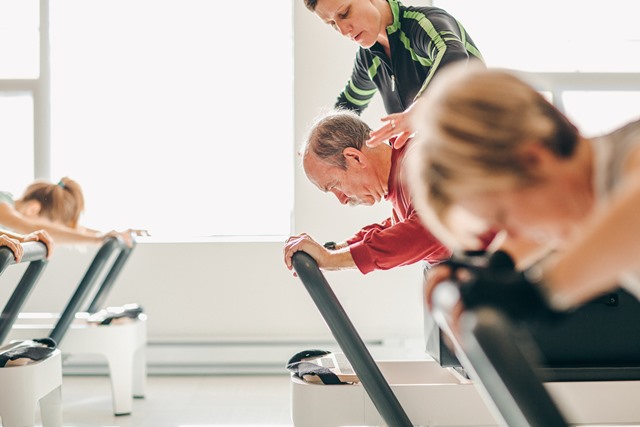If you have a family member, friend or loved one who needs to get back on their feet after physical therapy or rehabilitation, Pilates can be helpful.
We all know that exercise is important to rebuild mobility, strength, balance and confidence after injury or surgery. But many people find it difficult to exercise after an injury or surgery – even after completing physical therapy. No matter how motivated you are, the road from the disability you feel now to the strength and the ability you want to feel in future can be daunting. The gap between physical therapy and traditional exercise programs can appear to be too big.
Pilates fills that gap. It is the missing link that can ensure better long-term success after rehabilitation. A Pilates exercise program will decrease the risk if re-injury and help you support your loved one in managing chronic conditions while at the same time increasing their overall fitness, wellness and independence.
What does Pilates do that many traditional exercise programs don’t? Most people know that Pilates builds core strength, but what a lot of people don’t know is that there is way more to Pilates and to core strength than strong abs.
Pilates builds strength and balanced muscles development from the inside out, starting with the deep inner unit of core muscles. It creates stability in the lumbar spine and pelvis. This base of core strength enhances postural alignment allowing for improved muscle recruitment and joint stability in the lower limbs, upper back, shoulders and neck.
We know many individuals do not continue to exercise after completing physical therapy and do not return to pre-injury activity levels. Why? Maybe they never exercised in the first place. It’s not part of their lifestyle. Maybe they are so used to being in pain that the idea of physical exertion terrifies them. They may have been previously highly-active and fit but are now discouraged by how decreased their fitness level has become and how prone they are to re-injury when they try to return to previous activity levels.
Many muscular-skeletal injuries arise from poor joint mechanics. Repairing the meniscus in the knee will deliver relief. But pain will persist and function will not improve if the muscle recruitment at the knee is compromised by faulty joint mechanics at the hip. The same can be said for any joint up and down the skeleton.
The underlying purpose of Pilates is to enhance physical function; to get the body working efficiently and without extra effort, energy or tension. It’s like fine-tuning the engine of a car. That is why Pilates works equally well for high-performance athletes as it does for post-rehab.
As the population ages, maintaining a good degree of physical fitness is paramount to avoiding, managing and mitigating the chronic conditions that arise from aging. For those whose activity level has been compromised by injury or surgery, the reverse is true.
A broken hip is the leading cause of entrance to a nursing home. Not because the broken hip is so bad, but because the resultant ramifications of the loss of ability and mobility set off a spiral of ill effects. The less active a person is, the less fit they become. The less fit they are the less capable they are in maintaining health and independence. It’s a downward spiral.
Pilates can start to reverse that spiral for anybody. Less pain plus more ability leads to more confidence and activity. Improved strength and fitness leads to healthier choices and more independence leading to better mental and physical health. The downward spiral of injury is reversed.
Of course all Pilates programs are not the same. In supporting your friend, loved one or family member on the journey back to optimal health, make sure you seek out Pilates practitioners who have the requisite comprehensive training and experience to apply post-rehab protocols and to create programs specific to your loved one’s needs.



Comments are closed.